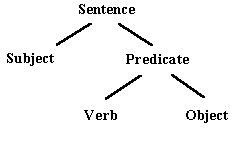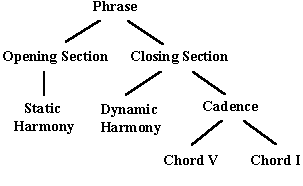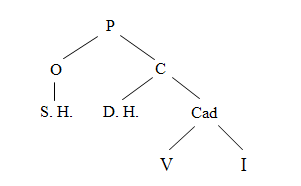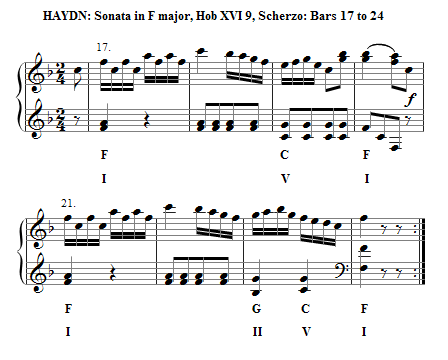
CHAPTER 1
THE BASIC SYNTACTIC STRUCTURE
Introduction
Conventional theories of structure in tonal music concentrate either totally on root progression patterns (Rameau. Schoenberg, etc) or totally on voice leading. (Schenker etc) This book is the first to explain how root progression patterns and voice leading work together. This book is based on a systematic analysis of root progression patterns in a large number of tonal (and tonally influenced) pieces of music and shows how chord progressions (once voice leading patterns have been addressed) create musical phrase structures similar to sentence structures in natural language.
Whilst voice leading principles are fairly well understood, what is new in this book is the explanation of how root progressions work in tonal music and how they interact with voice leading. When viewed from this perspective, it is possible to demonstrate that musical phrases are constructed in ways that show similarities with the way sentences are structured in natural languages. This makes it possible to explain every chord in its context within the musical phrase rather than just in terms of the chords surrounding it.
This book is about what is normally referred to as tonal music. By tonal music, I mean music that is composed in a recognisable system of scales and chord patterns as exemplified by the European classical tradition of the 18th and 19th centuries and to some extent the 20th century. Most of the music we listen to: classical, popular music, jazz, world music, etc. is constructed to some extent along tonal lines. People are often puzzled about why this system, which at first sight, is so simple - just a scale of seven diatonic notes (plus 5 chromatic notes) arranged in different patterns - actually produces such a wealth of possibilities. What I hope to show is that what gives tonal music the ability to form these varied structures is, the way voice leading and root progression patterns work together and the way chord progressions are organised into musical phrase structures similar to structures in natural languages.
Some writers such as Weber, Schoenberg, McHose and Piston have described chord progressions but only in terms of tables of probabilities. These tables tell us nothing about the relationships between the chords themselves or between the chords and musical phrases. Schenker proposed a theory of musical structure based totally on voice leading but this does not adequately explain how root progressions work or how musical phrases are structured. A full thesis is in preparation which contains more about the history of relevant theories and about the research behind this theory. The Q and A section of this site also has further information on the history of such theories.
In demonstrating the role that chord progressions have in creating syntactic structures, the author does not intend to imply that other components of music do not also play a role. Chapter 8: Full Musical Analyses shows the link between voice leading and chord progressions; the link between voice leading and motivic and melodic structures, and the link between chord progressions and musical phrase structures. Chapter 6: Extended Musical Structures will further explore this subject.
The Connection with Language
Language has evolved well organised structures because it gives human beings an evolutionary advantage. It allows us to communicate: - to pass information about our environment, about the location of food and warnings of danger. It enables us to agree plans and to pass traditions, ideas and techniques from person to person and from generation to generation. Because this is so important to our survival as a species it is an ability we have evolved over tens of thousands of years. It communicates messages, feelings and emotions and we enjoy the experience.
Based on the evidence collected about the patterns in chord progressions, it seems likely that the mind's innate ability to understand language structures has been transferred to the western system of music we describe as tonal music. Analysis of modal music and tonally related music shows that these musical systems (at least when harmonised) also share some of the patterns that are evident in tonal music.
As tonal music evolved over several centuries, it seems that composers have subconsciously emulated the underlying grammatical structures which exist in language. Because the underlying structures are common to all languages, these musical structures can be understood by anyone, anywhere in the world. Hence tonal music is accessible to many cultures and the harmonic structures in tonal music have influenced the popular music of many other musical traditions. Composers have not planned things this way or designed the tonal system. It has evolved through a series of experiments and discoveries that have gradually built on each other. This was necessary as western art music developed beyond accompaniment to song or dance into a self-contained art form with internal structures of its own.
Whilst Chord syntax and voice leading syntax are well documented and understood. What is missing is chord progression syntax and the interaction between the two syntaxes. This theory is the first that attempts to accurately describe these. By filling these gaps we can more fully describe the syntax of musical language.
In language, structures are formed in sentences made up of parts of speech. The joining of these parts of speech into sentences is governed by the rules of sentence syntax. For example, the basic structure of a sentence in the English language can be represented in a parsing diagram as follows:

This diagram indicates that a sentence is divided into two parts: the subject and the predicate. The predicate is itself divided up into two parts: the verb followed by the object. This represents the simplest complete sentence structure and although more complex structures are possible they all derive from this simple structure. One method of adding complexity is by further division of the branches. For example, the subject could be a noun or could be expanded into a pronoun + noun or further expanded to include a noun phrase or verb phrase.
These underlying principles also apply to musical structures, There is one basic phrase structure in tonal music and all other phrase structures are derived from this basic structure.
For more on the role of syntax in music click here
The Basic Musical Phrase Structure
It might be assumed that the basic element of the syntactic structure in music is the chord, but in order to make the connection between the chord and the musical phrase an intermediate level is required. This is the syntactic element which is identifiable as blocks of harmony of one of two types: static harmony and dynamic harmony. (This analysis of harmony is anticipated by Schoenberg and others but they do not make the connection with the musical phrase.) In the basic syntactic structure in music, harmony that is static is made up of: only the tonic chord (elaborated by voice leading patterns) or an oscillation of the tonic chord with other structural chords. Harmony that is dynamic is made up of chord progressions. It is because chords can be formed into these two basic types of grouping that music can be formed into structures similar to language structures. The basic phrase structure in music ends with the cadence which in tonal music is most commonly made up of the dominant and tonic chords (chords V and I), which complete the basic musical phrase structure.
In this way, the phrase in music is the equivalent of the sentence in language. The basic syntactic structure for tonal music can be represented as follows:

The basic musical phrase structure is very common and occurs at important points in compositions. For short pieces, it is sometimes the whole structure. In larger pieces, it is often the first phrase and also the last phrase in the piece and occurs at other important positions in a piece. It is so prevalent that we hear it subconsciously as the base standard that modifications are measured against. Just as there is one basic structure in language, that is modified in various ways, the basic structure in tonal music is modified in similar ways. Modified structures are not arbitrary variations, rather they are used as ways of creating larger scale structures just as subordinate clauses and phrases in language are used with the basic language sentence structure to create larger scale structures. They are important in creating form. More will be covered on these variations in Chapters 5 and 6.
Abbreviations can be used if desired as follows:

Where:
|
P
|
= | Phrase |
|
O
|
= | Opening Section of the Phrase |
|
C
|
= | Closing Section of the Phrase |
|
S.H.
|
= | Static Harmony |
|
D.H.
|
= | Dynamic Harmony |
|
Cad
|
= | Cadence |
|
V
|
= | Dominant Chord |
|
I
|
= | Tonic Chord |
The parsing diagram shows the sequence of the elements of the basic structure but it also shows the logical relationship between the static and dynamic elements and the cadence. For instance, whilst the static harmony is independent of the other two elements, the Dynamic Harmony and Cadence are shown under one heading. This is because the Dynamic Harmony and Cadence combine to create a larger dynamic harmony structure. So what is marked as Dynamic Harmony is in reality "the dynamic harmony leading to the Cadence". I only point this out to show the meaning of the hierarchy. The Cadence is shown separately because it has an important syntactic function in its own right. It determines the boundary of the phrase, anchors the static and dynamic elements in their place in the phrase and determines the key which is arrived at, at the end of the phrase.
The static harmony establishes the tonic at the start of the phrase and creates the context of the music by indicating the style and introducing the main melodic elements. The dynamic harmony develops these and makes the movement to the cadence. It either supports the key established in the static harmony or it can create a movement to a new key. The dynamic harmony usually elaborates on melodic elements from the static harmony. The Cadence confirms the key arrived at and indicates the end of the phrase. The most common and structurally important cadence in tonal music is the V to I "perfect cadence" or "complete close" which is why the cadence is shown in this way. Other variations are possible but this is the "reference standard" that other variations make reference to. For more on cadences (including modal cadences) see cadence in the glossary of terms.
As a short example, of this simple structure, let us examine the following 8 bar phrase from the Scherzo of Haydn's Sonata in F major, Hob XVI: 9:

We know that this is a complete musical phrase because it starts at the beginning of the melody and ends with a perfect cadence, C major to F major (chord V to chord I). From bar 17 to bar 21, the phrase is composed of tonic harmony (F major) with just one movement to a dominant chord (C major) at bar 19 and back to the tonic at bar 20. As the harmony just oscillates around the tonic there is no overall movement and consequently the harmony is static harmony.
At bars 22 to 24, in contrast, the harmony changes to a chord progression as follows: I (F major) to II (G minor) to V (C major) to I (F major). There is a clear root movement here. In chord progressions, it is the root of the chord that is important rather than the bass. The chord root rises a single step (a rising 2nd) from F to G, then rises three steps, (a rising 4th) from G to C, then rises a further rising 4th from C to F. This creates a sense of movement up to and including the V - I cadence. This is dynamic harmony.
The full book will contain further example(s) of this basic structure.
There are also further examples in demos 1 and 2.
This switching between static harmony and dynamic harmony happens in all tonal music and the simple structure above is the basis of all chord progression syntax in tonal music. In conventional theory chords are classified in terms of their function in relation to keys. This tends to disguise underlying progressions especially when they go across key structures. This topic is further discussed throughout the remainder of the book. For further examples of simple harmonic structures then please refer to the animated demonstrations. Longer phrases will have longer static elements and/or longer dynamic harmony elements. More complex musical phrases can be explained as expansions of this basic structure by combining complete and incomplete structures in various ways and by expanding some elements of the standard structure. These extensions are summarised in Chapters 5 and 6.
The reader will at this point no doubt be asking the question: 'Well, if this is so simple why has no one ever noticed it before?' One reason for this is that most theories of musical structure concentrate totally on voice leading or assume that root progressions can be explained without any reference to voice leading.
In order to establish the true chord progressions, whether static or dynamic, it is necessary to determine which chords are significant (or functional) in the progression and which chords are passing in nature (non-functional). These non-functional chords arise out of voice leading patterns just as the surface detail of the music does. Whilst in many examples (including the ones above) there are no non-functional chords to muddy the waters, when they are present they can disguise the underlying static and dynamic structures so that the voice leading patterns need to be analysed clearly in order to determine which chords are significant and which are not.
Some theorists argue that the analysis of root progressions is a futile exercise; that it is not always easy to determine what the correct root of a chord is, and that for some note combinations it is not possible to determine roots at all. Schenker believed that all chords arise from counterpoint and he gives particular importance to the role of linear progressions in creating chord sequences. The correct analysis of chord progressions depends on decisions about which vertical note combinations are significant in the analysis and which note combinations do not constitute structural chords. Given this necessary selection process, the suspicion may be that in finding patterns in chord progressions, the theorist has in some way selected chords and progressions that fit the theory and has rejected note combinations that do not fit the desired results. In fact, this is one of the principle objections to Schenker's Fundamental Structure - that the means of its derivation are not independent of the results themselves. (1)
To overcome this problem, the selection of note combinations must be applied in a consistent manner and in such a way that is independent of the end result. In other words, the reduction of music to an harmonic outline that lends itself to adequate root progression analysis, must be carried out by a system of rules that is as objective as possible. These are based, here, on the well established principles of voice leading (or more correctly "divisions"). This is explained more fully in Chapter 3. By working this way, it will be shown that chord progressions show clear patterns and that these patterns are similar to the grammatical structures in language. For more on Voice Leading see the Voice Leading Appendix.
Summary
Note: The following is a summary of the theory presented in this book/website. The details will become clearer on reading the ensuing chapters.
This theory may be summarised as follows:
All phrases in tonal music are organised into syntactic structures, similar to those in language. These are constructed in three levels: The phrase, the syntactic elements (of the type static harmony or dynamic harmony) and the chords. In tonal music, complete phrases usually terminate in a perfect cadence (chord V to I) . Static harmony in the basic structure is made up of a prolongation of the tonic chord by voice leading only or by oscillations between the tonic chord and other structural chords. Dynamic harmony is made up of chord progressions constructed mainly from strong root progressions (rising 4th, falling 3rd and rising 2nd). This selection of progressions for dynamic harmony I will refer to as the polarisation of chord progressions. In order to make visible the underlying chord progression the surface voice leading must be first accounted for. This means some chords might appear to be structural but in fact arise purely out of voice leading. These are not significant in the root progression analysis. This concept can be described as functionality. Non-functional chords include passing chords and chords which do not have clear roots such as the diminished seventh chord.
The basic syntactic structure may be extended by the further expansion of one of the syntactic elements in the basic structure. For example, the cadential V chord may be extended by dominant static harmony to form a dominant prolongation and the cadential I chord may be extended by tonic static harmony to form a static coda. See Chapter 5: Internal Extensions.
Complete and incomplete structures may also be "conjoined" to form larger structures. In some situations incomplete structures can be embedded within complete phrase structures. Variations on the basic structure will be further explained in Chapter 6: Extended Phrase Structures.
(1). Narmour, Beyond Schenkerism

